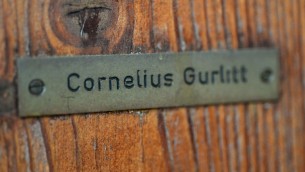News:
Bonn and Bern team up to show controversial Gurlitt collection
By Catherine Hickley
Exhibition aims to “contribute to transparency” as researchers investigate how much of the art was looted by the Nazis

Cornelius Gurlitt's art hoard is due to go on show in Bern and Bonn.
The Bundeskunsthalle in Bonn and the Kunstmuseum in Bern announced plans for a joint exhibition of Cornelius Gurlitt’s controversial art collection later this year—even before it is clear who will inherit the hoarder’s trove or how much of it was looted by the Nazis.
When Cornelius Gurlitt died in 2014, he left his cache of around 1,500 works to the Bern museum in his will. His cousin Uta Werner challenged that bequest on the basis that he was not of sound enough mind to write a will. Her challenge was rejected in a first ruling. She appealed, and the Upper Regional Court in Munich has yet to reach its decision.
The Bundeskunsthalle and the Berne Kunstmuseum say the exhibition, initiated by German Culture Minister Monika Grütters, will aim to “contribute to finding clues about the unknown provenance of works” in the collection, according to a joint statement. Yet until the Munich court ruling, the collection is in legal limbo, in the custody of the administrator of Gurlitt’s estate.
“This exhibition planning is premature,” says Louis Rönsberg at SLB Kloepper in Munich, the lawyer representing Werner. “We may not get a court decision until the autumn. It looks as though Minister Grütters is trying to pressure the court into making a quick decision in favour of the Kunstmuseum, and that could easily backfire.”
Gurlitt inherited the trove of art he hid in his homes in Munich and Salzburg from his father Hildebrand, an art dealer who worked for the Nazis. After its discovery became public in 2013, the German government set up a task force to investigate the provenance of the collection. In two years it identified five works as looted by the Nazis and recommended that they be returned to their previous owners.
Rönsberg says he believes an exhibition will not yield additional information on the provenance of the artworks in the collection.
“It would be more useful to put better photographs of the collection online and publish all the business letters and documentation that was found in Gurlitt’s homes,” he says.
The two museums said they are planning to produce a joint catalogue and have appointed teams of curators. Matthias Frehner, the director of the Kunstmuseum Bern, will work with the curator Valentina Locatelli on the Bern exhibition, while Rein Wolfs and Agnieszka Lulinska will organise the Bundeskunsthalle show. A team of advisers comprising Esther Tisa Francini, Georg Kreis, Gilbert Lupfer, Uwe M. Schneede and Shlomit Steinberg will accompany both exhibitions.
The organisers said they are examining the possibility of exchanging the exhibitions between the two museums and moving them on to further destinations, including a stop at the Martin-Gropius-Bau in Berlin.The Bundeskunsthalle in Bonn and the Kunstmuseum in Bern announced plans for a joint exhibition of Cornelius Gurlitt’s controversial art collection later this year—even before it is clear who will inherit the hoarder’s trove or how much of it was looted by the Nazis.
When Cornelius Gurlitt died in 2014, he left his cache of around 1,500 works to the Bern museum in his will. His cousin Uta Werner challenged that bequest on the basis that he was not of sound enough mind to write a will. Her challenge was rejected in a first ruling. She appealed, and the Upper Regional Court in Munich has yet to reach its decision.
The Bundeskunsthalle and the Berne Kunstmuseum say the exhibition, initiated by German Culture Minister Monika Grütters, will aim to “contribute to finding clues about the unknown provenance of works” in the collection, according to a joint statement. Yet until the Munich court ruling, the collection is in legal limbo, in the custody of the administrator of Gurlitt’s estate.
“This exhibition planning is premature,” says Louis Rönsberg at SLB Kloepper in Munich, the lawyer representing Werner. “We may not get a court decision until the autumn. It looks as though Minister Grütters is trying to pressure the court into making a quick decision in favour of the Kunstmuseum, and that could easily backfire.”
Gurlitt inherited the trove of art he hid in his homes in Munich and Salzburg from his father Hildebrand, an art dealer who worked for the Nazis. After its discovery became public in 2013, the German government set up a task force to investigate the provenance of the collection. In two years it identified five works as looted by the Nazis and recommended that they be returned to their previous owners.
Rönsberg says he believes an exhibition will not yield additional information on the provenance of the artworks in the collection.
“It would be more useful to put better photographs of the collection online and publish all the business letters and documentation that was found in Gurlitt’s homes,” he says.
The two museums said they are planning to produce a joint catalogue and have appointed teams of curators. Matthias Frehner, the director of the Kunstmuseum Bern, will work with the curator Valentina Locatelli on the Bern exhibition, while Rein Wolfs and Agnieszka Lulinska will organise the Bundeskunsthalle show. A team of advisers comprising Esther Tisa Francini, Georg Kreis, Gilbert Lupfer, Uwe M. Schneede and Shlomit Steinberg will accompany both exhibitions.
The organisers said they are examining the possibility of exchanging the exhibitions between the two museums and moving them on to further destinations, including a stop at the Martin-Gropius-Bau in Berlin.


